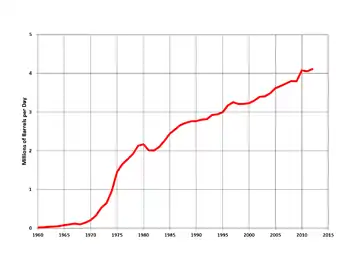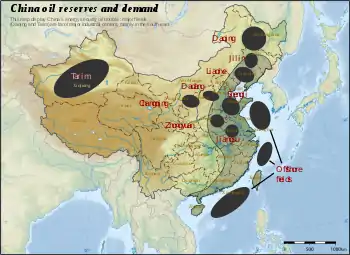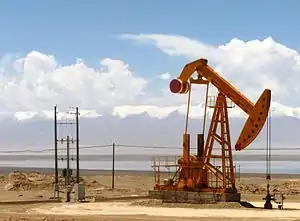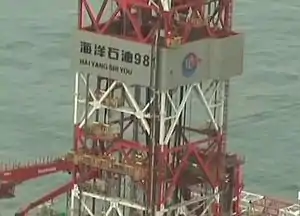Petroleum industry in China
The impact of the petroleum industry in China has been increasing globally as China is the fourth-greatest oil producer in the world.[1][2]

China imported a record 6.7m barrels a day (b/d) of oil in 2015 and was forecast "to overtake the U.S. as the world’s biggest crude importer in 2016"[3][4] According to the Energy Information Administration (EIA) China first became the "world's largest net importer of petroleum and other liquids" by the end of 2013.[1]
History
Early history
Before the development of the industry, Chinese oil production was measured in quarts and output used solely as a lubricant. The first well, developed under the most primitive of conditions and with relatively untrained personnel, began to produce over twenty barrels of oil a day.
In time, with equipment brought in from Szechuan and elsewhere and the development of several distillation plants, nine more wells were drilled in the immediate area of Yumen wells which then had a capacity of about 1,000 barrels of oil and 10,000 gallons of gasoline a day, except in winter when cold weather caused the oil to congeal. This was the first major oil field in China.
Ensuring adequate energy supply to sustain economic growth has been a core concern of the Chinese government since 1949.[5]
In 1956 a rail link was built to Lanzhou; until then, the oil was transported out by truck. A pipeline was constructed in 1957. The Yumen refinery was enlarged and modernized, and by the late 1960s it was reported that production from that area was "about two million tons".[6]
In 1959, large reserves were discovered in Songhua Jiang-Liao basin in northeast China and later several other giant oilfields were found.[7] The most important is the Daqing oil field in Heilongjiang that has been the backbone of Chinese oil production for many decades.[8]
Export era
In 1973, as production increased, China began exporting crude oil to Japan, and began offshore exploration. Exports increased to 20 million tons in 1985, before internal consumption began increasing faster than production. By 1993, internal demand for oil exceeded domestic production, and China became a net oil importer.[9]
Import dependence
Although China is still a major crude oil producer, it became an oil importer in the 1990s. China became dependent on imported oil for the first time in its history in 1993 due to demand rising faster than domestic production.[5] In 2002, annual crude petroleum production was 1,298,000,000 barrels, and annual crude petroleum consumption was 1,670,000,000 barrels.
In 2006, it imported 145 million tons of crude oil, accounting for 47% of its total oil consumption.[10][11]
By 2008, much of China's oil imports derived largely from Southeast Asia, but its growing demand forced it to import oil from all over the globe.
In 2013 the pace of China's economic growth exceeded the domestic oil capacity and floods damaged the nation's oil fields in the middle of the year. Consequently, China imported oil to compensate for the supply reduction and surpassed the US in September 2013 to become the world's largest importer of oil.[2]
Domestic production

A big role is played in China's oil endowment by its state owned oil companies, mainly China National Offshore Oil Corporation, China National Petroleum Corporation, China National Refinery Corp, and Sinopec.
Province started producing in 1960, and by 1963 was producing nearly 2.3 million tons of oil. Production from Daqing declined, but in 1965, oil fields in Shengli, Shandong, Dagang, and Tianjin yielded enough oil to nearly eliminate the need of importing crude oil. In 2002, annual crude petroleum production was 1,298,000,000 barrels, and annual crude petroleum consumption was 1,670,000,000 barrels.[10]
In 2005 China began to take drastic measures with its internal oil reserve programs as domestic oil production in China supplied only two-thirds of its needs and the estimated consumption requirement by 2020 was about 600 million tons of crude oil.

Oil drilling platforms

The largest oil field in the South China Sea, the Liuhua 11-1 field - located 210 km southeast of Hong Kong in the Pearl River Mouth Basin offshore south China, was discovered by Amoco (now BP) in January 1987 in typhoon alley.[12]:151 Water depth, the presence of heavy oil and a "very strong bottom-water drive" were among the technical challenges that had to be resolved before the oil could be extracted.[12] Amoco and Nanhai East engineering teams experimented with offshore drilling techniques, floating production, storage and off-loading system (FPSO) that would have drilling and production support.[13] By 2008, the FPSO had equipment capable of handling 65,000 bbl of oil and 300,000 bbl of total fluids per day and it would be loaded and shipped by shuttle tankers.[13]
In 2010, oil blocks in Wushi oil field (off Zhanjiang, near Hainan) began to be auctioned to foreign companies, with CNOOC having the option to increase its stake to 51% whenever required.[14]
China's $1 billion oil drilling rig, the Haiyang Shiyou 981 - owned and operated by the China National Offshore Oil Corporation - in the South China Sea, Ocean Oil 981 - began its first drilling operations in 2012.[15][16] It led to protests and hence had to be shifted back.[17]
Foreign production
This shift to dependence on foreign oil has changed the exploration and acquisition policies of China. China's oil need overwhelmed its internal capabilities.
China National Offshore Oil Corp, China National Petroleum Corp, and Sinopec have largely invested in exploration and development in countries that had oil fields but do not have funds or technology to develop them. In 2004 CNOOC signed a deal to extract a million barrels of oil a day in Indonesia as well as other projects with Australia.[18] In addition, an oil reserve that would theoretically fill with 30 days worth of oil has begun construction in China. However, their oil policy on the world oil market was not completely clear as to how they would deal with the situation as a whole.
The Chinese government is taking diplomatic action to improve their relationship with ASEAN states. According to a 2008 report, the Chinese government had to take extra strides to secure good relationships with its neighbors. Malaysia is a neighbor state that was often seen as in contention with China because of political differences. Yet, the relationship with Malaysia was symbiotic because of their large supply of oil and their need for security assurances from China. In 2008 Malaysia was the number one producer of petroleum in the South China Sea, and they account for over one half of the production in the region.[19]
Energy Security
Strategic Petroleum Reserve
China has one of the world's largest strategic oil reserves. Global strategic petroleum reserves (GSPR) refer to stockpiles of crude oil held by countries (and private industry) for national security during an energy crisis.
By 2004 China was investing in its first national oil reserve base to avoid foreign dependence. There are three different provinces in which they are focusing. The first Zhoushan, Zhejiang Province, was built by Sinopec, China's largest oil refining company. The storage space is 5.2 million cubic meters says the National Development and Reform Commission.[21] Zhejiang was originally a commercial oil transfer base. Its coastal position makes it convenient for movement purposes, although it is at the same time vulnerable to offshore violence. The next reserve of interest In Huangdao or Qingdao, Shandong Province and the final Dalian, Liaoning Province. All of these reserves are coastal and with their creation comes vulnerability to possible coastal attacks. In 2007, United Press International journalist questioned energy security, as all three of the stock oil bases were within range of Taiwanese cruise missile attacks.[22] These stockpiling strategies, as well as the international acquisition companies, are state-run initiatives to combat supply disruption.
According to a 2007 article in China News, at that time China's expanded reserve would include both mandated commercial reserves and a state-controlled reserves and would be implemented in three stages to be completed by 2011.[23] The state-controlled reserves phase one consisted of a 101,900,000 barrels (16,200,000 m3) reserve to be completed by the end of 2008. The second phase of the government-controlled reserves with an additional 170,000,000 barrels (27,000,000 m3) was to be completed by 2011.[24] In 2009 Zhang Guobao, head of the National Energy Administration, announced the third phase that would expand reserves by 204,000,000 barrels (32,400,000 m3) with the goal of increasing China's SPR to 90 days of supply by 2020.[25]
The planned state reserves of 475,900,000 barrels (75,660,000 m3) together with the planned enterprise reserves of 209,440,000 barrels (33,298,000 m3) will provide around 90 days of consumption or a total of 684,340,000 barrels (108,801,000 m3).[26]
Along with an emphasis on defensive oil stocks, there is a significant push to create an offensive oil acquisition program.
Transportation
In 2004, China had to import 100 million tons of crude oil to supply its energy demand, more than half of which came from the Middle East. China is attempting to secure its future oil share and establish deals with other countries. Communist Party general secretary Hu Jintao has proposed to build a pipeline from Russian oil fields to support China's markets as well as other billion-dollar arrangements with Russia, Central Asia, and Burma, and diversify its energy sector by seeking imports from other regions of the world and by starting alternative energy programs such as nuclear.[20]
In 2009 China completed its first critical oil pipeline, the Atyrau-Alashankou oil pipeline (Kazakhstan–China oil pipeline) in Central Asia,[27][28]:2–3 as part of a larger overall trade expansion with the Central Asian region which represented a trade volume of over $US $50 billion by 2013, up from $1 billion in 2000.[28]:1
See also
References
- "International energy data and analysis" (PDF). U. S. Energy Information Analysis. May 2015. p. 36. Retrieved 14 January 2016.
- "China overtakes US as the biggest importer of oil". BBC News. 10 October 2013. Retrieved 11 October 2013.
- "Meet the Chinese Newcomers Staking a Claim to Global Oil Trading". Bloomberg News. 12 January 2016. Retrieved 14 January 2016.
- "$20 is the new $40; The oil market", The Economist via Gale, 418, 15 January 2016, retrieved 15 January 2016Gale number:8972
- Andrews-Speed, Philip (November 2014). "China's Energy Policymaking Processes and Their Consequences". The National Bureau of Asian Research Energy Security Report. Retrieved December 5, 2014.
- Marvin Weller (1984), pp. 393-394.
- Höök, Mikael; Tang, Xu; Pang, Xiongqi; Aleklett, Kjell (2010). "Development journey and outlook of Chinese giant oilfields". Petroleum Exploration and Development. 37 (2): 237–249. doi:10.1016/S1876-3804(10)60030-4.
- Tang, Xu; Zhang, Baosheng; Höök, Mikael; Feng, Lianyong (2010). "Forecast of oil reserves and production in Daqing oilfield of China". Energy. 35 (7): 3097–3102. doi:10.1016/j.energy.2010.03.043.
- King, Byron (June 2005), "Investing in Oil: A History", The Daily Reckoning
- "China's oil imports set new record". Bloomberg BusinessWeek. Retrieved 2011-02-02.
- "China's 2006 crude oil imports 145 mln tons, up 14.5 pct – customs", Forbes, archived from the original on November 19, 2007
- Heubeck, C.; Story, K.; Peng, P.; Sullivan, C.; Duff, S. (2004), "An integrated reservoir study of the Liuhua 11-1 field using a high-resolution three-dimensional seismic data set" (PDF), Seismic Imaging of Carbonate Reservoirs and Systems: AAPG Memoir, Houston, Texas, 81: 149–168
- "Liuhua 11-1, South China Sea, China", Offshore-Technology, 30 March 2008
- "Notification of First Batch of Blocks in Offshore China Available for Foreign Cooperation in Year 2010". www.cnooc.com.cn. CNOOC. Archived from the original on 21 September 2017. Retrieved 21 September 2017.
- 11 May 2012, 南海钻井平台上工人直升机上下班, NetEase News
- "Not the usual drill: Tensions mount dangerously in contested waters". Singapore: The Economist. 10 May 2014. Retrieved 14 January 2016.
- "The Operation of the HYSY 981 Drilling Rig: Vietnam's Provocation and China's Position", Ministry of Foreign Affairs, the People's Republic of China, Beijing, 6 August 2014, retrieved 15 January 2016
- Hoffmann, Fritz (18 October 2004), "China's Quest for Oil", TIME
- "South China Sea and Natural Gas." Global Security. 2 April 2008 <http://www.globalsecurity.org>
- Ponikelska, Lenka; Subrahmaniyan, Nesa (15 April 2008), "China Buys Stake in BP; Investment Is 'Welcomed' (Update2)", Bloomberg
- Chang, Andrei. "Analysis: China's Fuel Oil Reserves." United Press International 21 December 2007
- Chang, Andrei (21 December 2007), "Analysis: China's Fuel Oil Reserves", United Press International
- "Suggested title: oil reserves (China)". China News. 19 July 2007. Archived from the original on 28 September 2007.
- "Archived copy". Archived from the original on 2009-02-27. Retrieved 2009-01-08.CS1 maint: archived copy as title (link)
- "suggested title: Chinas Energy Security Strategy". China Sourcing Blog. October 2009.
- "Countries Compared by Energy > Oil > Consumption. International Statistics at NationMaster.com". www.nationmaster.com.
- "Kazakhstan-China oil pipeline opens to operation". Xinhua. 12 June 2006. Archived from the original on 11 April 2009. Retrieved 15 March 2008.
- Cooley, Alexander (18 March 2015). "China's Changing Role in Central Asia and Implications for US Policy: From Trading Partner to Collective Goods Provider" (PDF). U.S.-China Economic and Security Review Commission. p. 8. Retrieved 14 January 2016.
Sources
- Weller, J. Marvin. Caravan Across China: An American Geologist Explores the Northwest 1937-1938. (1984). March Hare Publishing, San Francisco. ISBN 0-918295-00-9.